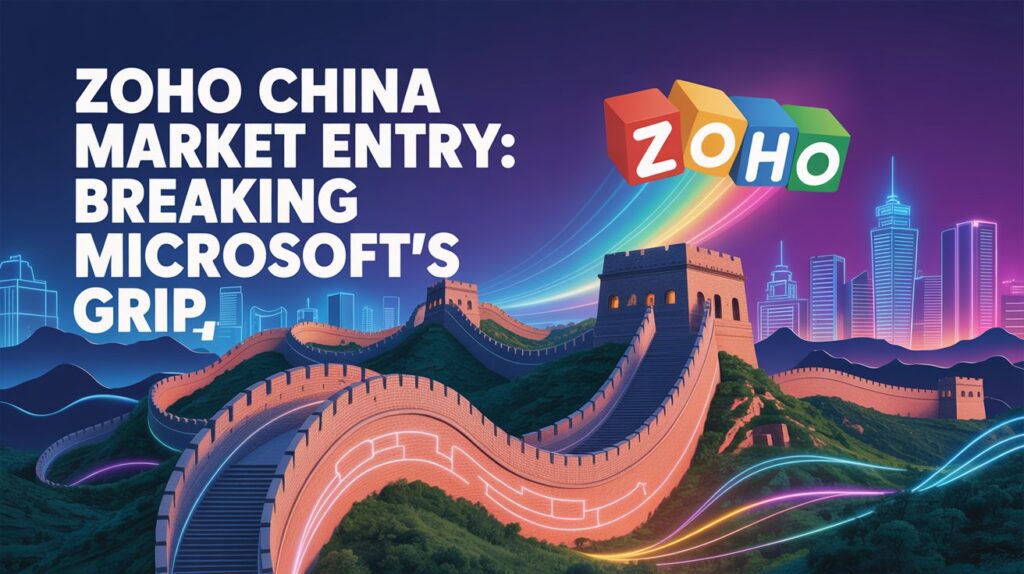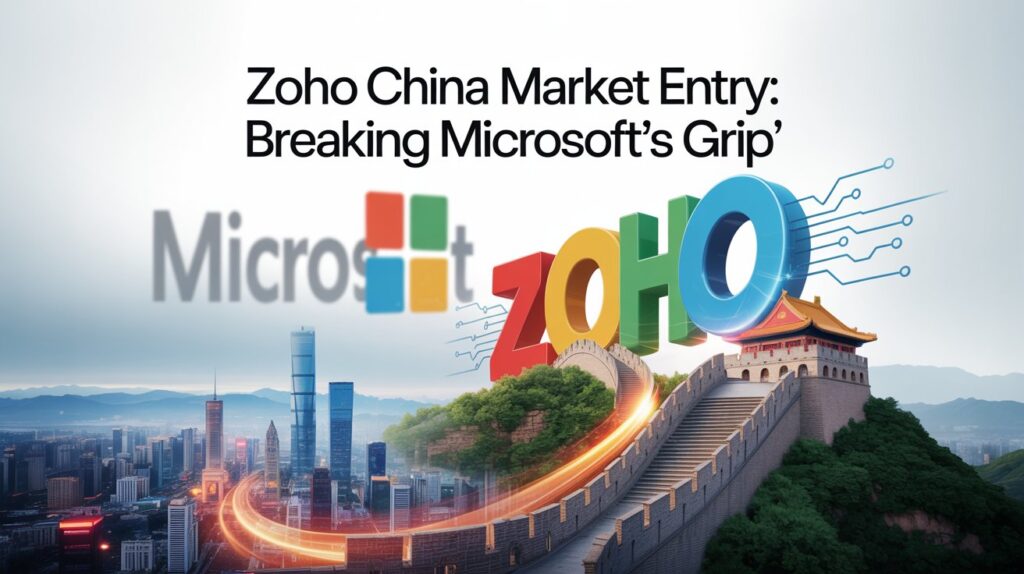How did Zoho crack China’s Great Firewall? Discover the 3 key strategies behind Zoho China market entry and how it’s reshaping global tech power away from Microsoft and the U.S.
What Makes Zoho China Market Entry a Turning Point for Global Tech?
Zoho China Market Entry is more than a business story, it’s a geopolitical milestone. In a market long considered impenetrable due to strict regulatory controls and the infamous “Great Firewall,” very few global tech companies have managed even a marginal presence.
Giants like Google, Facebook, and Amazon tried and failed, hindered by restrictive laws, data sovereignty requirements, and a political climate favoring domestic champions.
Against this backdrop, Zoho, a privately held Indian SaaS company headquartered in Chennai, has not only entered China but is positioning itself as a formidable competitor to global incumbents like Microsoft.
This success underscores a larger shift in global tech power. Zoho’s strategic moves reflect India’s growing digital diplomacy and the emergence of a “Chindia” narrative—an implicit collaboration in technological and economic space between the world’s two most populous nations.
By localizing operations, respecting data sovereignty, and targeting the price-sensitive SME market, Zoho has turned a market barrier into an opportunity. Its victory signals that Indian tech companies can now aspire to global product leadership, challenging entrenched Western monopolies in critical markets.
Why Did Western Tech Giants Fail Behind China’s Great Firewall?
China has historically been one of the toughest markets for foreign tech companies. The “Great Firewall” limits access to platforms like Google, Facebook, Twitter, and Instagram, effectively blocking companies that cannot fully comply with domestic cybersecurity laws.
Beyond technical restrictions, the political and regulatory environment prioritizes domestic innovation and data sovereignty. This creates a significant trust deficit for foreign firms.

Western companies repeatedly struggled to navigate these requirements. Google’s limited search operations in China were constantly under scrutiny. Social media giants like Facebook and Twitter never managed official access. Amazon’s e-commerce operations could not compete with entrenched local players like Alibaba or JD.com.
Data localization was non-negotiable, and most companies balked at full transparency with Chinese regulators. This combination of regulatory complexity, cultural differences, and geopolitical sensitivities made success highly improbable.
Zoho China Market entry coincided with a time of shifting geopolitical alignments. With the Shanghai Cooperation Organization (SCO) emphasizing regional technological collaboration, the broader “Chindia” framework provided a strategic window for Indian companies.
Zoho’s timing was impeccable, demonstrating an awareness of the intersection between business strategy and geopolitics.
How Did Zoho Build Trust and Localize Effectively in China?
Zoho’s approach centered on deep localization and trust-building, a critical differentiator from its Western counterparts.
Rather than merely opening a sales office, Zoho established a full operational hub in Beijing’s Haidian District, often referred to as China’s “Silicon Valley.” This presence allowed for real-time engagement with both regulatory bodies and local customers.
Cultural fluency played an equally important role. Zoho launched a localized portal (zoho.com.cn) and hired Chinese teams for sales, IT support, and software development. These teams understood not only local business practices but also the nuanced cultural expectations that Western companies often overlook.
Data sovereignty was another cornerstone. Zoho invested in a China-based data center, providing transparency and complete access for regulatory oversight. Unlike many Western companies that resisted local data storage requirements, Zoho embraced them, demonstrating reliability and compliance.
This move addressed one of the primary barriers for foreign entrants and was instrumental in gaining approval to operate widely across Chinese urban centers.
How Is Zoho Winning China’s SME Market Through Pricing and Integration?
Zoho China Market Entry strategy emphasizes integration and affordability. Its ecosystem includes over 40 business applications, ranging from CRM and marketing automation to project management and analytics tools.
While Microsoft and other U.S. firms often rely on multiple vendors to cover these needs, Zoho provides a unified solution that simplifies IT infrastructure for SMEs.
Targeting China’s Small and Medium Enterprise (SME) sector proved particularly strategic. SMEs drive a significant portion of the country’s e-commerce and digital economy, making them a highly lucrative demographic.
Zoho’s pricing model is intentionally accessible, undercutting both local competitors and Western incumbents. By delivering a comprehensive suite at a fraction of the typical cost, Zoho quickly gained adoption among SMEs seeking efficient, cost-effective solutions.
This combination of localized offerings, competitive pricing, and an integrated ecosystem created a distinct value proposition. SMEs could adopt Zoho’s tools without navigating fragmented software landscapes or incurring exorbitant costs.
What Does Zoho China Market Entry Strategy Reveal About India’s Digital Diplomacy?
Zoho’s success carries implications far beyond business metrics. It demonstrates India’s ability to influence global tech governance, asserting sovereignty and innovation without reliance on Silicon Valley capital.
Zoho is privately held, having consistently rejected venture funding, which allowed the company to make decisions independently and align its operations with broader strategic objectives rather than external investor pressures.
Strategically, Zoho’s achievements challenge the narrative that Indian companies are primarily service providers or outsourcing entities. By establishing a significant footprint in one of the most competitive and regulated markets, Zoho has validated Indian innovation at a global scale.
This accomplishment enhances India’s geopolitical leverage in digital spheres, positioning Indian technology as a capable alternative to U.S. monopolies like Microsoft and SAP.
Moreover, Zoho China Market Entry model signals the potential for replicable strategies in other high-barrier markets, particularly within BRICS nations. India can now project influence not only through talent and services but also through product leadership, shaping global standards and expanding its soft power in technology governance.
What Key Lessons Can Global Tech Firms Learn from Zoho’s Playbook?
Zoho China market entry provides three clear lessons for companies aiming to operate in politically and technically complex markets:
| Strategy | Implementation | Global Impact |
|---|---|---|
| Deep Localization | Full Chinese operational hub, local teams, zoho.com.cn | Builds trust and ensures cultural acceptance in protected markets. |
| Data Sovereignty | China-based data center with regulatory transparency | Overcomes barriers like the Great Firewall and regulatory scrutiny. |
| Integrated Value | 40+ applications in one low-cost ecosystem | Captures SMEs from under both local and global competitors, challenging incumbents like Microsoft. |
These principles—trust, compliance, and integrated value delivery demonstrate that success in regulated markets is less about sheer capital and more about strategic alignment with local priorities.
Western firms often underestimated the importance of cultural fluency and regulatory collaboration, whereas Zoho embraced these as foundational pillars.
Frequently Asked Questions
Q1: Why did the Chinese government allow Zoho to enter while blocking other global giants?
Zoho’s compliance with data sovereignty and regulatory transparency differentiated it from Western firms. By establishing a local data center and providing full oversight to authorities, Zoho addressed critical government concerns about privacy, security, and control.
Q2: How does Zoho compete with Chinese tech giants like Alibaba and Tencent?
Zoho targets the SME sector with a comprehensive suite of over 40 integrated applications. Its affordable, value-driven approach and operational localization allow it to complement rather than compete head-on with large domestic firms, filling a market gap in SMEs seeking scalable and integrated solutions.
Q3: What does Zoho China Market entry mean for India’s global tech reputation?
This move showcases India’s capability to produce global product-led companies rather than service-oriented firms. It validates the nation’s technological innovation, strengthens its soft power, and signals to the world that Indian SaaS companies can succeed in complex, high-barrier markets.
Q4: Is Zoho’s China operation a minor project or a significant market presence?
Zoho’s operations are extensive, spanning multiple cities with brand visibility in airports, metro stations, and digital advertising channels. This demonstrates a strategic, long-term commitment and positions Zoho as a credible challenger to entrenched incumbents.
Q5: How is this a challenge to Microsoft’s global dominance?
Microsoft relies on high-cost, multi-vendor ecosystems. Zoho’s integrated, localized, and affordable platform provides a competitive alternative in a strategic growth market. By penetrating China, a market largely closed to Western firms, Zoho indirectly challenges Microsoft’s global business software hegemony.
8. Related Articles
- The Rise of Chindia: Economic Cooperation and Tech Strategy
- The Secrets of Localization: Why Translation is Not Enough for Global Market Success
- How Indian Unicorns Are Changing the Global SaaS Landscape
10. References
- China Internet Regulation and Market Access
- Zoho’s Global Strategy Insights
- SME Digital Economy in China
- Microsoft’s Global Market Strategy





